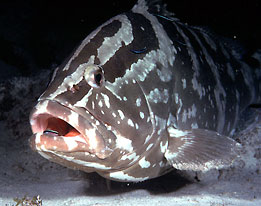Twenty groupers threatened with extinction

IUCN – World Conservation Union
Press Release
Twenty species of grouper, a globally important group of 162 coral reef food fishes, are threatened with extinction unless management or conservation measures are introduced. This was the conclusion of a panel of twenty experts from 10 countries at a recent conservation summit convened to assess the status of groupers worldwide. Groupers are the basis of the multi-million US$ live reef fish market of the sea food trade centered in Hong Kong, where consumers can pay up to US$50 per kg for this delicacy. Groupers are also the most valuable commercial fishes in the fresh fish markets of the tropics and sub-tropics.
The ground-breaking workshop, held at the Department of Ecology & Biodiversity of the University of Hong Kong, is the “first time that fishery data and population information for groupers have been globally and systematically assessed using IUCN criteria”, said Dr. Yvonne Sadovy, Chair of the IUCN Grouper and Wrasse Specialist Group and Associate Professor at HKU, who organized the workshop. “The results are worrying and highlight the urgent need for better fishery management, more effective marine protected areas (MPAs) and more research on these important but vulnerable species” she added.
“The workshop forms part of a growing focus on the problems of overfishing, and conservation concerns for fishes in general, and will contribute to a massive new initiative, the Global Marine Species Assessment, led by IUCN and Conservation International and “which aims to examine the conservation status of all fishes, globally”, says Kent Carpenter, of Old Dominion University, Virginia, USA.
The need to better protect outer and deep reef fish populations and habitats, and the spawning (reproductive) aggregations of these species, was identified as being particularly important for a number of the threatened grouper species assessed. Outer and deep reef habitats are often not included in MPAs, and protection of spawning aggregations—critical to the maintenance of exploited populations of many threatened groupers are rarely incorporated in fishery management plans; they can rapidly eliminated by uncontrolled fishing. The increasing international trade of these reef fishes poses a major threat because of the insatiable demand (and resulting high prices) for groupers.
The workshop outcome serves as yet another reminder of the need to limit exploitation levels to the natural ability of fish populations to sustain them. The threatened groupers are naturally vulnerable to overfishing, and if fish populations continue to decline, this can threaten food security and livelihoods in source countries, as well as the species concerned. The urgency of the IUCN Red List listings also reflects the widespread failure to successfully manage fisheries associated with coral reefs.
“Groupers are some of the oldest fishes on coral reefs – some groupers may be more than 50 years old – and several do not reach maturity until late in life, making them particularly vulnerable to fishing before they are able to reproduce” says Matthew Craig of the Hawaii Institute of Marine Biology. Add to this the fishing pressure on the spawning aggregations of adults, the targeting of juveniles for food and for capture-based mariculture and the ongoing loss of reef habitat worldwide, and there seems little opportunity for unmanaged populations to be replenished.
As just one example, two species of coral trout grouper (Plectropomus areolatus and P. laevis), mainstays of the live reef food fish trade in Hong Kong, and both species that aggregate for spawning, were listed as Vulnerable based on the IUCN Red List criteria. Although currently these species are seen in local Hong Kong markets, the heavy and unmanaged fishing pressure that they are exposed to is rapidly reducing populations and will continue to do so unless their fisheries are controlled. Groupers are so prized in Hong Kong and southern China, and so depleted on many corals reefs of SE Asia, that they are imported alive by air or sea, from as far away as south Pacific and the Indian Ocean.
And it is not just the live fish trade that threatens grouper species. In North and South America, heavy fishing for these highly desired food fish also poses a significant threat. As just one example, the Nassau grouper (Epinephelus striatus) is listed as Endangered; yet this was once one of the most commonly landed groupers in the islands of the western Atlantic. While it has virtually disappeared from most Caribbean reefs, the species continues to be fished in many parts of its range and receives little effective management protection anywhere.
“Loss of such species will affect not only source countries but also local and international trade that depends on them, and people who like to eat them, so everybody loses in the end” said Dr. Sadovy.
Contact information:
Dr. Yvonne Sadovy .(JavaScript must be enabled to view this email address) +852 2299 0603
Dr. Kent Carpenter .(JavaScript must be enabled to view this email address)
Dr. Luiz Rocha .(JavaScript must be enabled to view this email address)